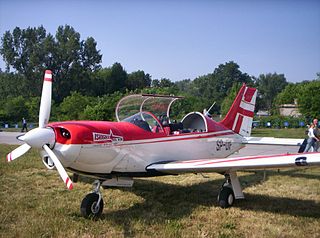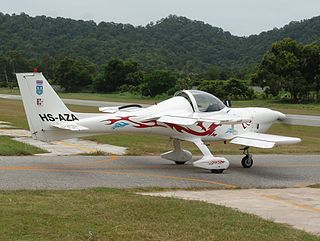Notes
Related Research Articles

The Pitts Special is a series of light aerobatic biplanes designed by Curtis Pitts. It has accumulated many competition wins since its first flight in 1944. The Pitts biplanes dominated world aerobatic competition in the 1960s and 1970s and, even today, remain potent competition aircraft in the lower categories.

The Cessna 210 Centurion is a six-seat, high-performance, retractable-gear, single-engined, high-wing general-aviation light aircraft. First flown in January 1957, it was produced by Cessna until 1986.

The Fletcher FU-24 is an agricultural aircraft made in New Zealand. Being one of the first aircraft designed for aerial topdressing, the Fletcher has also been used for other aerial applications as a utility aircraft, and for sky diving.

The ASH 26 is an 18 metre Class glider, built of modern fibre reinforced composites. It first flew in 1993. It is manufactured by Alexander Schleicher GmbH & Co. The 'H' indicates this is a design of Martin Heide.

PZL M26 Iskierka or M26 Airwolf is a Polish trainer and aerobatic aircraft, designed at WSK PZL-Mielec.

Saab MFI-15 Safari, also known as the Saab MFI-17 Supporter, is a propeller-powered basic trainer aircraft used by several air forces.

The Eagle Aircraft 150 is an Australian designed two-seat single-engine composite material training, touring and sport aircraft. It utilizes a three lifting surface design consisting of a forward wing (foreplane), main wing (mainplane) and horizontal stabilizer (tailplane). The aircraft was designed and originally built by Eagle Aircraft Pty Ltd, but is now manufactured in Malaysia by Composites Technology Research Malaysia (CTRM).

The PZL-105 Flaming (flamingo) is a Polish short-takeoff-and-landing (STOL) utility aircraft designed by PZL "Warszawa-Okęcie". It remained a prototype.

The Robin HR100 is a French four-seat light monoplane, designed by Chris Heintz and built by Avions Pierre Robin as metal-winged version of the Robin DR253 Regent.

The Valentin Taifun is a two-seat self-launching sailplane designed and built by Valentin Flugzeugbau GmbH of Hasfurt, Germany.

The Ruschmeyer R 90 is a four-seat light aircraft designed and produced in Germany in the late 1980s and early 1990s.

The PZL M-24 Dromader Mini, originally named the Lama, is a single engine agricultural aircraft, developed in the 1980s by WSK-Mielec from the PZL-Mielec M-18 Dromader. The prototype, registration SP-PDM, first flew on 18 June 1982. It did not progress beyond the prototyping stage.
The Hongdu N-5,, originally known as the Nanchang N-5, is a Chinese agricultural aircraft. First flown in 1989, and entering into production in 1992, the N-5 is a single-engined low-wing monoplane, and is available in versions powered by a piston engine or a turboprop.

The Dream Tundra is a single-engine, high-wing monoplane designed in Canada. Seating four, its short takeoff and landing characteristics can be adapted to land, snow, or water use. It is produced as a kit for homebuilding.

The Grinvalds Orion is one of the earliest (1981) composite kit- and homebuilt aircraft. A 2/4 seater with a single pusher engine, it was built in France and the United States in small numbers with several variations.
The Aircorp B2-N Bushmaster is a prototype Australian light aircraft designed for aerobatic, touring, and utility use. It first flew in 1989 and did not enter production.
The Aviones de Colombia AC-05 Pijao is an agricultural aircraft manufactured in Colombia in the 1990s. It was developed to fill a gap in the local market after Cessna discontinued production of the Cessna 188 that Aviones de Colombia had been assembling and supporting. Although the Pijao resembles the Cessna 188 in appearance and role, it was, at least to some degree, a new design. "Pijao" is the name of an indigenous people of Colombia.
The Phönix-Aviatechnica LKhS-4 was a 1990s Russian design for a civil utility aircraft of unusual configuration. Its designation is an acronym of Legkiy Khozyaystvennyy Samolet — "light utility aircraft" in Russian. In addition to general aviation purposes, the LKhS-4's intended use was air-taxi and commuter roles throughout the CIS and it was therefore designed to be able to operate from soft snow or mud.
The Interavia I-1L Leshiy, also produced as the Phönix-Aviatechnica SL-90 Leshiy is a light aircraft first manufactured in Russia in the 1990s. A Leshiy is a type of forest spirit in Russian folklore.
The Celair Eagle 300 was a light aircraft with STOL capability developed in South Africa in the late 1980s and early 1990s. Only a single prototype was constructed.
References
- ↑ Davisson 1996, p.66
- 1 2 3 4 5 6 Lambert, Munson & Taylor 1991, p.4
- 1 2 3 4 5 6 7 8 9 10 Eyre 2019
- 1 2 3 4 5 6 7 8 9 Lambert, Munson & Taylor 1991, p.5
- ↑ Australian Stock Exchange 1998, pp.27, 135
- 1 2 3 4 5 6 Lambert & Munson 1994, p.6
- ↑ Aircraft register
- 1 2 Davisson 1996, p.67
- 1 2 Jackson 1995, p.6
Bibliography
- The 1998 ASX Delisted Companies Book. Brisbane: Australian Stock Exchange. 1998.
- "Aircraft register". Civil Aviation Safety Authority. Retrieved 29 June 2024.
- Davisson, Budd (February 1996). "All Part of a Long-Range Plan". Sport Aviation. Vol. 45, no. 2. Oshkosh, Wisconsin: Experimental Aircraft Association.
- Eyre, David C. (8 May 2019). "Eagle Aircraft Eagle X-TS". Aeropedia. Retrieved 29 June 2024.
- Jackson, Paul, ed. (1995). Jane's All the World's Aircraft 1995-96 (86th ed.). Coulsdon, Surrey, United Kingdom: Jane's Information Group.
- Lambert, Mark; Munson, Kenneth; Taylor, Michael J.H., eds. (1991). Jane's All the World's Aircraft 1991-92 (82nd ed.). Coulson, Surrey, UK: Jane's Information Group.
- Lambert, Mark; Munson, Kenneth, eds. (1994). Jane's All the World's Aircraft 1994-95 (85th ed.). Coulson, Surrey, UK: Jane's Information Group.
- Taylor, Michael J. H. (1993). Jane's Encyclopedia of Aviation. London: Studio Editions.